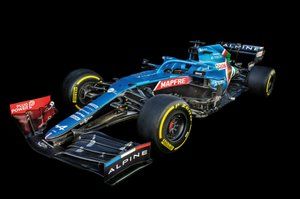Why Alpine's F1 engine boss isn’t obsessed with its horsepower figures
After as big a shake up to the Formula 1 grid as there has been in 2022, it has been hard to pick out the influence of chassis and power units in the changing form.

Photo by: Mark Sutton / Motorsport Images
Questions about whether or not the Mercedes power unit has fallen back have, for example, been clouded by its underperforming chassis and the drag levels of its high-downforce wing.
At the opposite end of the debate, at Alpine it has been hard to split how much of its progress have come from aero and how much from its engine.
What isn't in doubt is that the all-new 2022 Renault E-tech power unit is a good chunk better than its predecessor, with the turbo hybrid certainly looking like it is closely matched to the other manufacturers.
But for Alpine executive director Bruno Famin, who is in charge of its engine programme, any intrigue over the exact horsepower figures are something he has no interest in.
That’s not because he doesn't worry about the products he is delivering though. Instead, it's because for him the end game is not having the most powerful engine in F1: it’s about the power unit becoming a part of the best car on the grid.
Push him on the progress Renault's engine made on the power front this year and his response is swift.
“To be honest I don’t care about that,” he says. “What I care about is the performance of the car.
“We made some choices on the PU to have the best car. Maybe we could have done a better figure on the dyno, but with a slower car at the end.
“Instead, the A522 has been designed with the engine, and the engine has been designed to get the best compromise for the best car. We will keep working in that way.”

Esteban Ocon, Alpine A522
Photo by: Mark Sutton / Motorsport Images
One obvious change aimed at helping improve the car, rather than peak power, was Renault finally adopting the split turbo and compressor solution that Mercedes pioneered all the way back in 2014.
It was a quite significant change but one the team knew would deliver gains for Enstone.
“It’s a good example of what I was saying, it's a better packaging mainly,” adds Famin. “It's the type of choice we made together with Enstone, but it's not the only one.
“It’s one of the examples of improving packaging of the car to have a better aero, to have a lower centre of gravity and to have, at the end, a better car - because the Alpine car will make the result and score points.”
Famin joined Alpine at the start of this year as part of the winter management shake-up brought about by CEO Laurent Rossi.
The Frenchman had spent the last three years at the FIA, as its director of operations. But before that he was best known for his role as technical director at Peugeot – where he played a key role in the Le Mans 24 Hours-winning 908 project and the company’s Pike Peaks victory in 2013.
He has been drafted in by Alpine to help drive Renault’s Viry-Chatillon engine facilities forward – and help better integrate its progress with the French manufacturer’s Enstone factory.
Changes are being made at Viry itself – which originally became part of the Renault motorsport infrastructure as long ago as 1976.
Famin says: “We keep investing in the facilities. We have a brand-new building for the engine, for the PU assembly.
“We are renewing all the ground floor in the historical building. More than that, we keep investing in new facilities, new dyno, new benches, new things to keep working, to prepare the development of the next generation.”

Fernando Alonso, Alpine F1 A522
Photo by: Erik Junius
But more than what equipment there is at Viry, for Alpine to achieve the success it is craving in F1, it knows that the chassis and engine must be integrated as much as possible.
And while removing the geographical problem of the chassis being produced in Enstone and the engine in Viry is not possible, Famin suggests things are better than a few years ago.
He believes that one of the impacts of the COVID-19 pandemic, where people were forced to work via video calls, is that now there is not much difference between chassis and engine people operating 30 miles or 350 miles apart.
“Maybe COVID helped us in that way,” said Famin. “COVID made everybody everywhere a new way of working together.
“If you have one guy in Enstone and one guy in Viry, it's almost the same as having one guy in Viry and one guy working in his house 20km from Viry.
“So, it's a new collaborative way, of course. We also send the right signs, in terms of senior management together with Otmar [Szafnauer, team boss], with Pat Fry and with Matt Harman. We are fully on the same line and we are sending the right messaging to our guys.
“The fact that the 2022 engine and cars are back in the game is proof of concept. The guys are understanding that this is the way to go at all levels. I think everything is looking in the right way, We will not fail on that one with Otmar, for sure.
“We know that it's the way to win, and we will push everyone on that route.”
Be part of the Autosport community
Join the conversationShare Or Save This Story
Related video
Subscribe and access Autosport.com with your ad-blocker.
From Formula 1 to MotoGP we report straight from the paddock because we love our sport, just like you. In order to keep delivering our expert journalism, our website uses advertising. Still, we want to give you the opportunity to enjoy an ad-free and tracker-free website and to continue using your adblocker.



















Top Comments